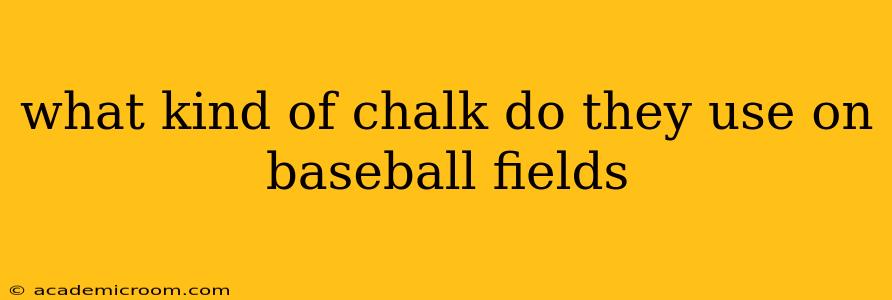Maintaining a pristine baseball field requires meticulous upkeep, and one crucial element is the type of chalk used for outlining the playing area. While it might seem like a simple detail, the chalk used plays a significant role in ensuring clear markings and a smooth playing surface. This article delves into the specifics of the chalk used on baseball fields, addressing common questions and misconceptions.
What is the Best Type of Chalk for Baseball Fields?
The best type of chalk for baseball fields is hydrated lime, also known as calcium hydroxide (Ca(OH)₂). This isn't the same chalk you'd find in a classroom; hydrated lime is a fine, white powder that's far superior for marking baseball fields for several key reasons:
- Visibility: Hydrated lime provides excellent visibility, particularly against the green grass, making the lines clearly defined even under bright sunlight.
- Durability: Unlike regular chalk, hydrated lime is less susceptible to being washed away by rain or heavy dew. It tends to last longer, requiring less frequent reapplication.
- Environmental Friendliness: Hydrated lime is a relatively benign substance compared to other marking materials, making it a safer choice for the environment and players.
While other types of chalk might seem like a cheaper alternative, they generally lack the visibility and durability required for professional or even serious amateur play.
What are the Differences Between Different Types of Chalk?
Several types of chalk exist, but for baseball fields, they generally fall short compared to hydrated lime:
- Regular Classroom Chalk (Calcium Carbonate): This is easily washed away and not durable enough for the demands of a baseball field.
- Colored Chalks: While visually appealing, colored chalks often lack the necessary durability and may not be approved for official games.
- Other Marking Materials: Paints and sprays might seem like a solution, but they can damage the field, be environmentally unfriendly, and are generally not permitted in organized baseball.
Hydrated lime offers the ideal balance of visibility, longevity, and environmental impact, making it the clear winner.
Is Hydrated Lime Safe for Players?
Yes, hydrated lime is generally considered safe for players when used correctly. However, it's essential to note the following:
- Eye Protection: Precautions should be taken to avoid getting hydrated lime in the eyes. Gloves and eye protection are recommended when applying it.
- Skin Irritation: While generally safe, some individuals might experience mild skin irritation. Using gloves is recommended to minimize this risk.
- Proper Application: Applying the hydrated lime in a controlled manner prevents excessive dust and potential inhalation.
When used and handled appropriately, the risk to players is minimal.
How is Hydrated Lime Applied to the Field?
Hydrated lime is typically applied using specialized field marking equipment. These machines efficiently and evenly distribute the lime, ensuring crisp lines and minimizing waste. Manual application is possible but less precise and efficient.
Where Can I Buy Hydrated Lime?
Hydrated lime can be purchased from various agricultural supply stores or companies specializing in sports field maintenance. It's crucial to source hydrated lime specifically intended for field marking.
This detailed guide clarifies the specifics of chalk usage on baseball fields, highlighting the reasons behind the choice of hydrated lime and addressing common concerns about its safety and application. Remember, using the right materials is crucial for maintaining a top-quality playing surface and ensuring a safe game for all participants.
